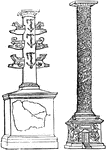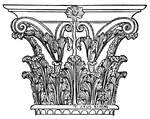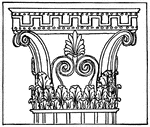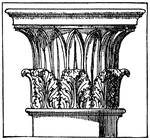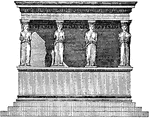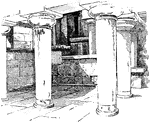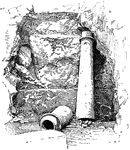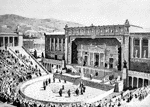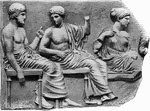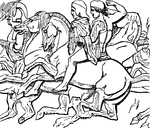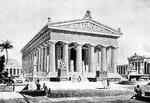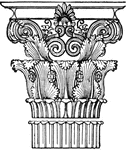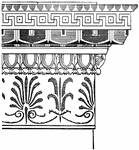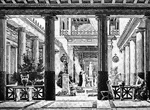This ClipArt gallery offers 209 illustrations of ancient Greek architecture.
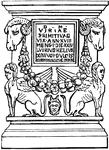
Cippus
"A low column, sometimes round, but more frequently rectangular. Cippi were used for various purposes;…
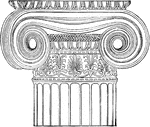
Ionic Angle Column from the Temple of Minerva Polias at Athens, Front
The good effect of the Ionic capital is really only produced by the front-view. It seems calculated…

Ionic Angle Column from the Temple of Minerva Polias at Athens, Side
The good effect of the Ionic capital is really only produced by the front-view. It seems calculated…

Doric Column from the Temple of Neptune at Paestum
The Doric columns, which are short, powerful, and closely ranged together, in order to support the weight…
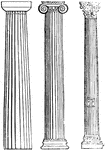
Columna
"A pillar or column. The use of the trunks of trees placed upright for supporting buildings, unquestionably…
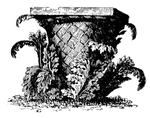
Corinthian Capital
A basket with acanthus leaves growing around it—the supposed inspiration for the Corinthian capital.

Greek Corinthian Order
The Corinthian order is one of the Classical orders of Greek and Roman architecture, characterized by…
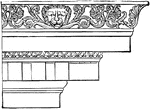
Ionic Cornice from the Temple of Minerva Polias at Priene
The entablature resting on the columns has three parts: a plain architrave divided into two, or more…
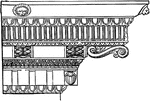
Corinthian Cornice
The Corinthian cornice is only distinguished from the Ionic by its mutules and modillions, which take…
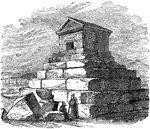
Tomb of Cyrus
"Cyrus caught sight of his brother Artaxerxes, whose person was revealed by the flight of his troops,…
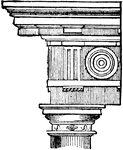
Doric Order
One of the three orders or organizational systems of Ancient Greek or classical architecture.
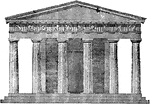
Doric Temple
"The front elevation of a Greek Doric Hexastyle-peripteral Temple." — Encyclopedia Britanica,…

Egg-and-Dart
Egg-and-dart is an ornamental device often carved in wood, stone, or plaster quarter-round ovolo mouldings,…
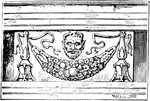
Encarpus
"In architecture, a sculptured ornament in imitation of a garland or festoon of fruits, leaves, or flowers,…
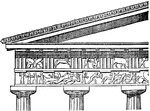
Doric Entablature
"Doric Entablature. E, entablature: a, epistyle or architrave; b, frieze; c, cornice." -Whitney, 1911

Erechtheum
"The 'house of Erechtheus'; a temple of Ionic order on the Acropolis of Athens, noted as one of the…
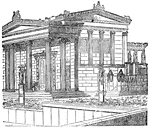
Erechtheum restored
"The building of the new Erechtheum was not commenced till the Parthenon and Propylea were finished,…

Erechtheum with the Pandrosium
Belonging to the time directly after Pericles is the Erechtheum. This is a double temple in the Ionic…
Exedra at the Street of Tombs in Assos
An exedra is a semicircular recess set into a building's facade. The exedra at the Street of Tombs in…

Fastigium
"An ancient Greek or Roman temple, of rectangular construction, is terminated at its upper extremity…
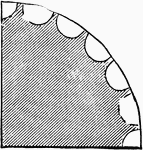
Fluting Plan of the Ionic and Corinthian Column
The Ionic column has a less diminished shaft and a smaller parabolic curve than the Doric. It is, like…

Doric Order Frieze in the Parthenon at Athens
The frieze of the Doric order is not taken up with sculpture in uninterrupted succession, but it occurs…
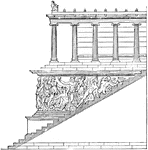
Frieze of Altar at Pergamon
The stairway of the great altar at Pergamon in Ancient Greece shows a frieze. A frieze is a sculpture…
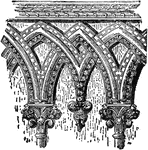
Drontheim Frieze
"A Frieze, in architecture, is that portion of the entablature which is between the architrave and the…

Greek Altar
"Round, triangular, or square in plan, often elaborately adorned with sculpture, and bearing inscriptions."-Whitney,…

Greek philosophers
"Greek Philosophy, which reached its highest excellence in Athens in the fourth century before Christ,…

